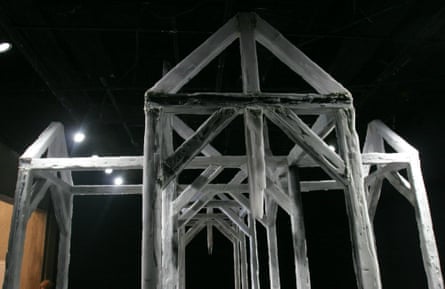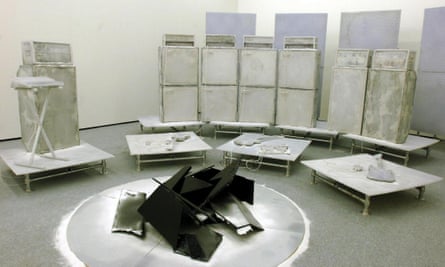If Christmas is the season for excess, then Banks Violette has made the perfect decorations. The artist has created 14 chandeliers out of industrial white fluorescent tubing and put each one in a different flagship branch of Celine, the French fashion house. A handful are suspended from the ceilings and look pristine but the rest are smashed and collapsed – one third vertically, another horizontally – and slump on the floor.
They are self-portraits of a sort, Violette tells me. “It’s in there,” he says over the phone from his house in Ithaca, Upstate New York, “this thing collapsing in a corner and passing out.” He says that he responds to sculptures that in some way also relate to the human body, such as Alberto Giacometti’s macabre 1932 work Woman with Her Throat Cut, an eviscerated body that looks like a mantrap. Another inspiration was the German artist Martin Kippenberger’s street lamps for drunks, where the poles are so bent over that the light is almost in the gutter, or the posts wave crazily around the pavement.
Violette calls his chandeliers an “updated Narcan Fentanyl derivative” of Kippenberger’s sculptures – Narcan being the nasal spray taken in the event of an opioid overdose. “Here’s this form collapsing and staggering,” he says. “It’s not a big stretch to think, ‘Here’s a fashion space, and I’m combining it with opiates and excess.’ That seems pretty on a par.”
It certainly does if you remember Violette from the mid-00s. Back then he was the world’s most celebrated black metal-inspired artist. I first met him on 06/06/06, a Satanically auspicious date he celebrated by getting a tattoo. A former tattoo artist, he already had plenty of ink on his skin, the centrepiece being a grinning skull in a helmet with an inverted cross and black wings plunging downwards on his chest. Violette was in London for his exhibition at Maureen Paley gallery in the east end. It opened with the experimental doom band Sun0))) playing in a bricked-up room, with the band’s then vocalist Attila Csihar in a sealed coffin. The performance was so loud it put a crack in the gallery wall. “Which to this day I am profoundly proud of,” Violette says. “This sounds awful, but the Luftwaffe did a number in that general area, and then this is what damaged the building!”

Violette grew up in Ithaca, dropping out of school after developing a crystal meth habit. He worked as a tattooist in Hawaii before cleaning up and deciding to focus on his art. He took his MFA at Columbia, New York, graduating in 2000. Whether using charred wood or black mirrors, ash or salt, motorbikes or banks of amplifiers, his bleakly beautiful, alarming and death-suffused work struck a nerve post-9/11, hailed as a new take on gothic romanticism. By 2005 he had an exhibition at the Whitney, the centrepiece of which was a charred wooden structure alluding to one of the churches burned down by black metal fans in Norway. An earlier installation, which featured black stalactites standing in for stab wounds, was inspired by teenage Slayer obsessives who killed a classmate in California.
“I love black metal for how deeply and primally problematic it is. Which is a terrible admission,” Violette says. “It’s beautiful in the same way that German Romanticism, like Caspar David Friedrich, inherently points towards National Socialism.” Indeed, the darkness and rage of the alienated young white men Violette froze in his art seemed to point towards sinister real world consequences, a decade before Trump’s election. “These lunatics have collided together and assembled this thing that is deeply horrifying but was always there,” Violette says. “It’s about as American as you get.”
Violette became part of a vanguard of young New York-based artists including Dash Snow, Ryan McGinley and Terence Koh inspired by nihilistic youth subcultures. For a few years they were the toast of hip galleries and stylish magazines. As his profile rocketed, however, this introverted metal fan was struggling. “I’ve always had a difficult time navigating social situations, which was why I made art,” Violette says. “The object will communicate for me. But there was this expectation that I had to be out at openings and be this social person.” A lot of his artist friends felt the same way, he adds. “My entire peer group then came to the miraculous solution to the problem of being in public by taking a shit ton of drugs, and the industry we were in didn’t seem to have a problem with that.”
Far from it – in fact, they were feted for their rock’n’roll behaviour. Looking back, Violette describes his peers as, “clearly sick in public, overworked, freaked out, doing very poorly”. But he says gallerists would “throw more money at them rather than address the underlying problem, and the consequences were tragic for a number of people”. Snow died of a heroin overdose in 2009, aged 27, while Violette left his New York studio in disarray and in 2014 returned to Ithaca. Addicted to heroin, he went through a cycle of withdrawal and relapsing which he describes as “a misery unlike anything else”, before finally kicking the drug and finding some stability. He married a woman he’d known when growing up in the town, and became stepfather to her two daughters. The last tattoo he got was an anchor on his foot spelling out the three women’s names in morse code.
after newsletter promotion




Violette says it was a long time before he felt able to make art again, as it seemed to come with an “overwhelming landslide” of negativity. “The amount of anxiety and, to be totally blunt, anger that I felt was the worst part of the entire experience,” he says. “This thing that was core, central, definitive to how I understood myself became inextricably tied to resentments and toxic behaviours.” His profile fell as quickly as it had risen, but some supporters such as Hedi Slimane, Celine’s creative director, remained loyal, and Violette is edging back into public view with a retrospective next year at BPS22 in Belgium.
While he misses the “machining and plastic fabrication and carpentry” his fancy New York studio enabled him to do, these days, if he needs to wire a sculpture, he calls an electrician rather than do it himself in a drug-fuelled frenzy. “I could barely maintain that kind of schedule when I was young, healthy and super, super high – I cannot do it sober and in middle age.” New ideas for sculptures keep coming, some perhaps to be situated in the spectacular landscapes around his house. “I’d like to make an abandoned gas station in the middle of nowhere, that lights up and just gets overgrown.”
Today, he’s inspired by friends he knew in his youth, who played in bands or ran record labels and are still involved in alternative culture in middle age. “It was never intended purely as this ‘fuck you’ shock gesture. There was an incredibly positive dimension, and seeing people who have maintained that without compromise is endlessly rewarding.” There will be no more tattoos however. He has run out of space and, what’s more, “I got this discovery which was profoundly shocking to me – ‘Wait, this hurts!’”
This post was originally published on this site be sure to check out more of their content.








